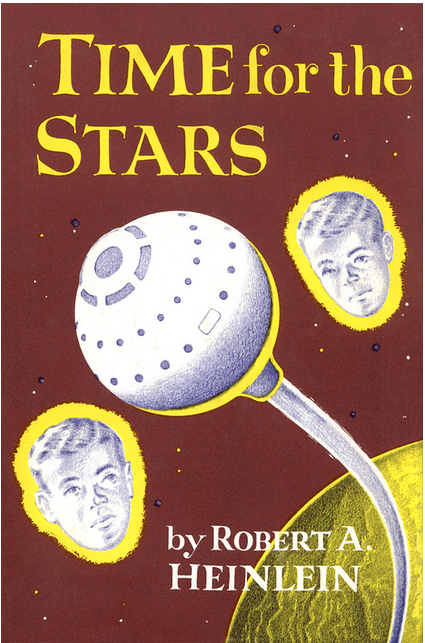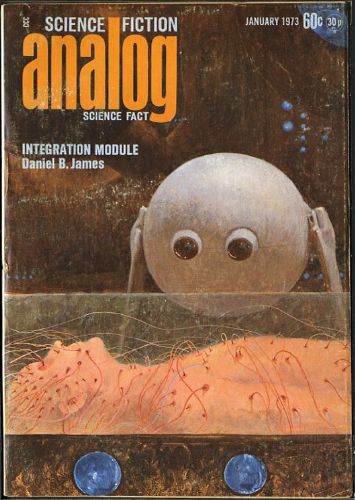(Walter Popp’s cover for the August 1952 issue of Fantastic Adventures)
The sphere — as a manifestation of the perfectly round geometrical shape or replete with various derivations and modifications (tentacles, slight elongations, eye sockets, limbs both fleshly or mechanical) — holds a particular fascination for sci-fi artists and authors. The possibilities are endless: spherical aliens, spherical ocean descent vehicles, spherical spaceships, spherical robotic doctors, wizards levitating spherical objects, and spherical legged war vehicles…
I’ve selected a delightful variety of these spherical manifestations. In my favorite (above) female scientists alternately shout about, gaze at, and document descending spheres — Walter Popp’s fantastic cover conveys unbridled enthusiasm and wonder. I find the menacing mass of a crumpling spheroid downright frightening in Emshwiller’s visual feast of a cover for Andre Norton’s The Defiant Ones!
Enjoy!
What are your favorites?
(Ed Emshwiller’s cover for the 1963 edition of The Defiant Agents (1962), Andre Norton)
(Hubert Rogers’ cover for the April 1950 issue of Astounding Science Fiction)
(John Schoenherr’s cover for the January 1973 issue of Analog Science Fiction/Science Fact)
(John Schoenherr’s cover for the 1967 edition of Against the Fall of Night (1948), Arthur C. Clarke)
(Robert Fuqua’s cover for the March 1939 issue of Amazing Stories)
(Leo Morey’s cover for the March 1935 issue of Amazing Stories)
(Uncredited cover for the 1965 edition of Crashing Suns (collection published 1965, stories from the late 20s/30s), Edmond Hamilton)
(Leo Morey’s cover for the February 1936 issue of Amazing Stories)
(Clifford N. Geary’s cover for the 1956 edition of Time for the Stars (1956), Robert A. Heinlein)
(Uncredited cover for the April 1952 issue of Fantastic Story Magazine)









The 1973 Analog is kind of cute and creepy at the same time.
Haha, that’s always been one of my favorite Analog covers — for that exact reason. At once cute and creepy — yet, well, emotions on a robotic face always make me laugh….
Those take me back a few years. That’s the kind of fun I cut my reading teeth on in the 50s and 60s. Great stuff, great post.
You’re welcome! Thanks for stopping by! My favorite sci-fi is from the 50s/60s/70s….
Great covers, thanks for sharing them! One of my favorites that uses spheres is the Astounding Stories cover from June 1936 for H. P. Lovecraft’s The Shadow Out of Time. Sure, they look a little goofy, but somehow they capture the spirit of the story.
Here’s a link to the cover:
http://thehogshead.org/happy-birthday-h-p-lovecraft-2663/
I love the old goofy covers 🙂 That one included… Thanks for the link!
The 1965 Crashing Suns cover is uncredited, but it definitely looks like an Ed Valigursky artwork.
I agree now that you’ve pointed that out! I’ll write that I think it’s Valigursky…. Thanks for stopping by!
Oh! This is cool! Consider yourself followed. Grand!
Thanks! Your blog looks great as well — anything about The Golden Age of sci-fi is worth reading 😉 hehe
Cool – who knew the simple sphere was so futuristic/space age? I’m relatively new to anything sci-fi… and it seems like I have a lot of reading to do! Your blog looks like a good place to start 🙂
Thanks for the kind words. My blog usually has a lot more book reviews but I’ve had a busy end of the semester (last chunk of PhD coursework — yay!). Well, my reviews tend to be along the more esoteric edges of science fiction — the lesser known works, authors, etc. if you’re new to the genre check out the Hugo Award lists for best Novel 🙂
I can almost hear the pink sphere on the cover of crashing suns now ‘are you feeling lucky, punk?’ Great pictures, as always 🙂
That cover screams phallic symbol — two spheres, etc… I dunno.., purposeful?
Ha, I don’t think that many of the old covers were done by women, thats for sure!
Nope. I’ve come across a few women sci-fi artists in the 60s and 70s but not earlier… Perhaps I’m missing a few but I’ve looked through entire catalogues of various publishers (Ballantine, Ace, Signet, etc).
Although, not all covers are credited…
Perry Rhodan has spherical spaceships with an equatorial circumferential ring that incorporates conical thrust engines for easy navigation. And telescopic landing gear protruding from the lower hemisphere. 🙂